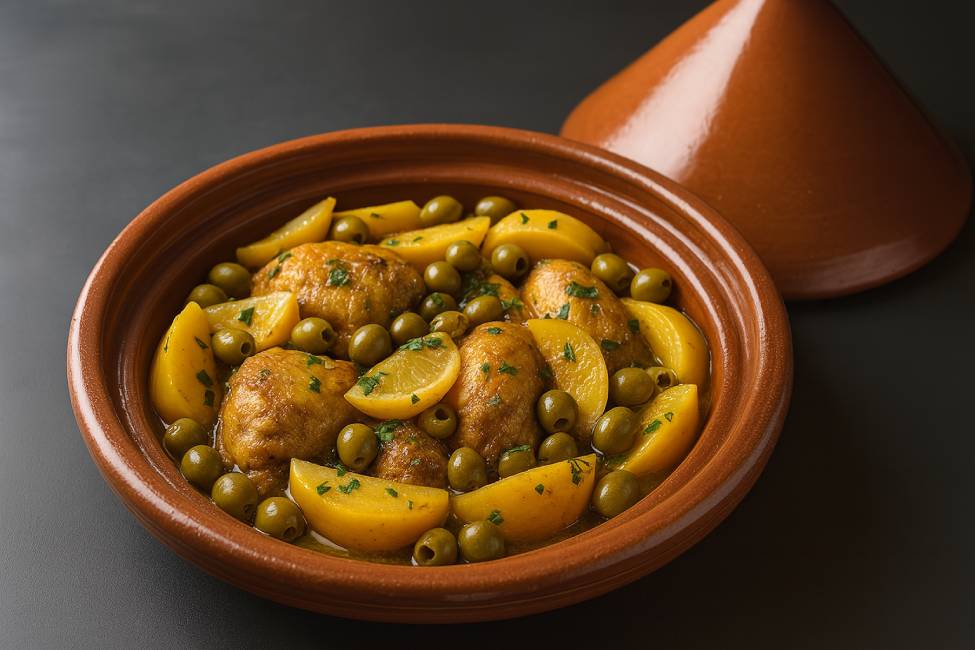Table of Contents
Introduction
Close your eyes and imagine the scent of simmering chicken blending with the sharp, salty aroma of preserved lemons. Picture tender potatoes soaking in golden broth, while green olives add their signature depth. This is not just any meal. It’s a true staple in Moroccan cuisine recipes, crafted with care and full of comfort.
This dish, known as tagine with potatoes, olives, and preserved lemons, holds a special place at Moroccan tables. It brings people together, warms the soul, and tastes like tradition. If you’ve ever wanted to create an authentic Moroccan tagine, this recipe is your perfect starting point.
In this guide, you’ll learn how to cook this chicken tagine using clear, simple steps. We’ll explore how to make it with or without a traditional tagine pot, highlight the key ingredients, and share tips to help you get the flavors just right. You’ll also discover the perfect sides to serve with it. Whether you’re cooking for guests or just for yourself, this easy tagine recipe will bring a taste of Morocco straight to your kitchen.
Why This Tagine with Potatoes, Olives, and Preserved Lemons is a Moroccan Masterpiece
The Quintessential Moroccan Flavor Profile
What makes this dish unforgettable is how each ingredient contributes to a perfect balance of taste. Preserved lemons bring a sharp, salty brightness that wakes up the whole recipe. Green olives add richness and depth. Potatoes soften into the sauce, soaking up every layer of flavor. And the chicken, cooked slowly with the spices, becomes tender and full of character.
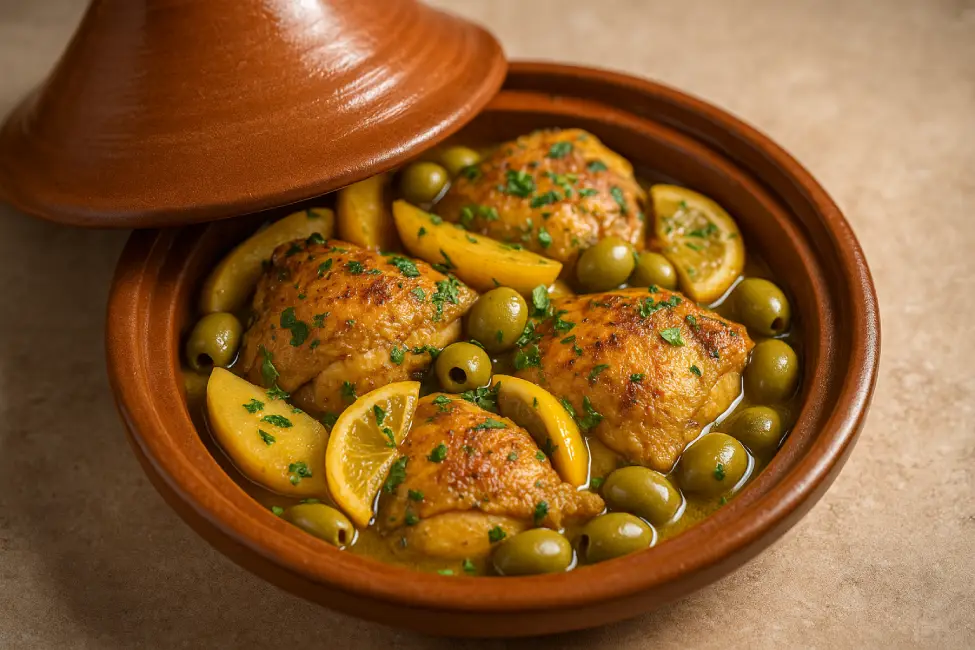
This is one of those Moroccan cuisine recipes that feels like home. It is the kind of dish you remember from family gatherings or weekend meals. This dish is a comforting tagine that not only warms your body but also your appetite. Many households consider it a must-serve when guests arrive or during important family meals.
If you’re exploring similar comforting dishes, take a look at this traditional Harira soup guide, which showcases another staple of Moroccan cooking, packed with flavor and heart.
Beyond the Basics: What Sets This Recipe Apart
What really makes this tagine shine is attention to the little details. Browning the chicken before simmering creates a strong base of flavor and helps lock in moisture. The way you layer the ingredients also matters. Start with a bed of onions, then place the chicken, and finish with the potatoes, olives, and preserved lemons on top. This method allows each component to cook properly without losing its texture.
The spices are kept simple yet effective. A touch of turmeric gives the dish its golden color. Ginger adds gentle warmth. Saffron, if available, brings a subtle aroma that lifts everything. Using just enough liquid helps the sauce reduce naturally, giving you a rich finish that clings to each bite.
According to Healthline, preserved lemons are not only a culinary powerhouse but also a source of beneficial probiotics. They bring both flavor and function to the dish.
These small techniques transform a basic chicken tagine into something memorable. They reflect the spirit of authentic Moroccan tagine cooking, where time, care, and simple ingredients work together in harmony.
Key Ingredients for Your Authentic Moroccan Tagine
Detailed Ingredient List with Notes
A delicious tagine starts with simple ingredients chosen with care. Each one plays a role in creating that deep, savory flavor you expect from Moroccan cuisine recipes. Here’s how to pick and use them correctly.
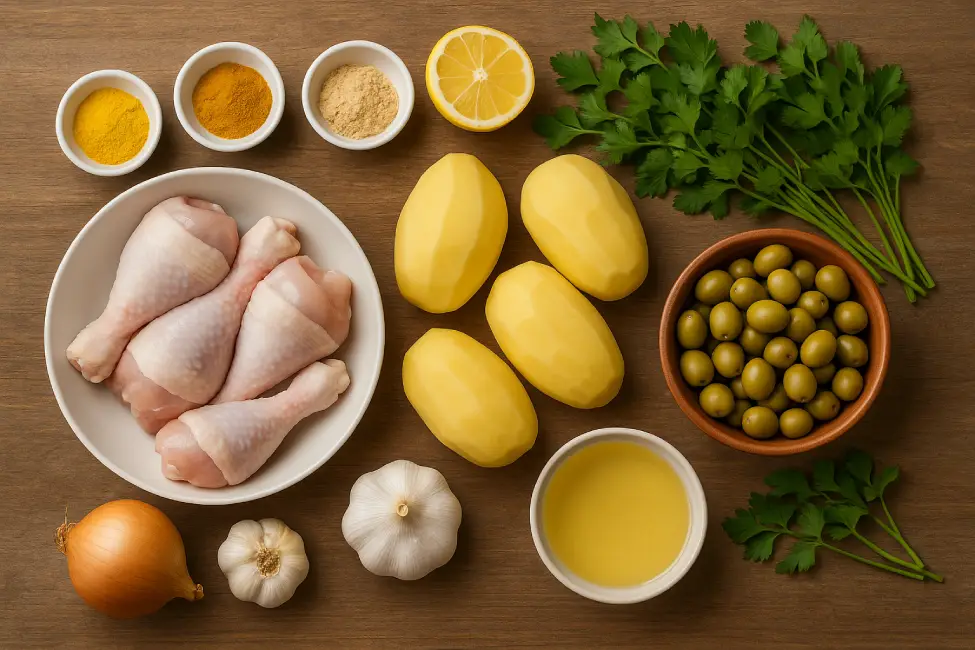
Chicken
Bone-in, skin-on chicken thighs or legs are best. They stay moist, absorb flavor, and release rich juices that create a natural broth. This cut holds up beautifully during slow cooking and gives the dish a comforting depth.
Potatoes
Use firm, waxy potatoes like Yukon Gold or red-skinned varieties. They keep their shape without turning mushy. Peel them and cut them into thick wedges so they hold up well as they simmer.
Olives
Beldi olives are ideal. Their wrinkled skin and strong briny taste are signature to Moroccan recipes. If you can’t find them, go for other green olives with mild saltiness. Pitting them is optional, depending on how rustic you want the dish.
Preserved Lemons
This ingredient defines the flavor of the tagine. Use only the rind, well rinsed, and discard the pulp. Preserved lemons add a tangy, salty brightness that lifts the entire dish. If you’d like to see how they enhance traditional recipes, check out our chicken tagine with lemons and olives for inspiration.
Onions and Garlic
Start your base with one large chopped onion and a few cloves of garlic. They create a smooth, aromatic layer that supports the spices and chicken juices.
Spices
The classic blend includes turmeric for color and earthy warmth, ground ginger for spice, a touch of black pepper, a pinch of cumin for aroma, and saffron if you have it. Even a small pinch of saffron brings out a rich fragrance and golden tone.
Herbs
Fresh parsley and cilantro are added during cooking and again at the end. They bring a burst of green freshness that brightens the final dish.
Liquid
light chicken stock. You don’t need much, just enough to help the ingredients steam and create a rich sauce at the bottom of the pot.
The Magic of Preserved Lemons Explained
Preserved lemons bring a flavor that is hard to describe but unforgettable. They add tang, salt, and depth. Unlike fresh lemons, they mellow out during cooking and blend perfectly with the olives and spices. Always rinse the rind before using, and chop it finely so it melts into the sauce.
If you’re curious about the science behind preserved lemon flavor and fermentation, Serious Eats breaks it down in a simple and practical way that’s easy to follow.
Choosing the Right Olives for Flavor
Olives are not just a garnish here. They are essential. Beldi olives are strong and slightly bitter, which balances the tang of preserved lemon. If you use milder green olives, the dish will taste softer, which some prefer. Avoid black olives, as their sweetness can clash with the other flavors.
Together, olives and preserved lemons create the bold, unmistakable character of an authentic Moroccan tagine. When chosen well, they make the difference between average and unforgettable.
Step-by-Step, How to Cook Your Tagine with Potatoes, Olives, and Preserved Lemons
🎬 Helpful Video on YouTube
If you prefer a visual walkthrough, here’s a helpful video from a YouTube creator showing how to prepare this Moroccan dish:
*Note: This video is from an external source and is not affiliated with Tajine Recipes. All credit goes to the original creator.*
Before You Start: Prep Work
A delicious tagine begins with simple, solid prep. Take your time to cut everything evenly and set up your ingredients in advance. It makes the cooking smoother and more enjoyable.
Chicken: Use bone-in, skin-on pieces. Pat them dry and trim excess fat.
Potatoes: Peel and cut into medium wedges. Avoid cutting them too small so they don’t fall apart while cooking.
Onion and garlic: Chop the onion finely. Crush or mince the garlic to release more flavor.
Herbs: Chop a small handful of parsley and cilantro for each.
Preserved lemon: Remove the pulp, rinse the rind, and slice it into thin strips.
Quick marinade: Mix olive oil with turmeric, ginger, salt, pepper, garlic, and chopped herbs. Rub it over the chicken and let it rest for 20 minutes while you prepare the rest.
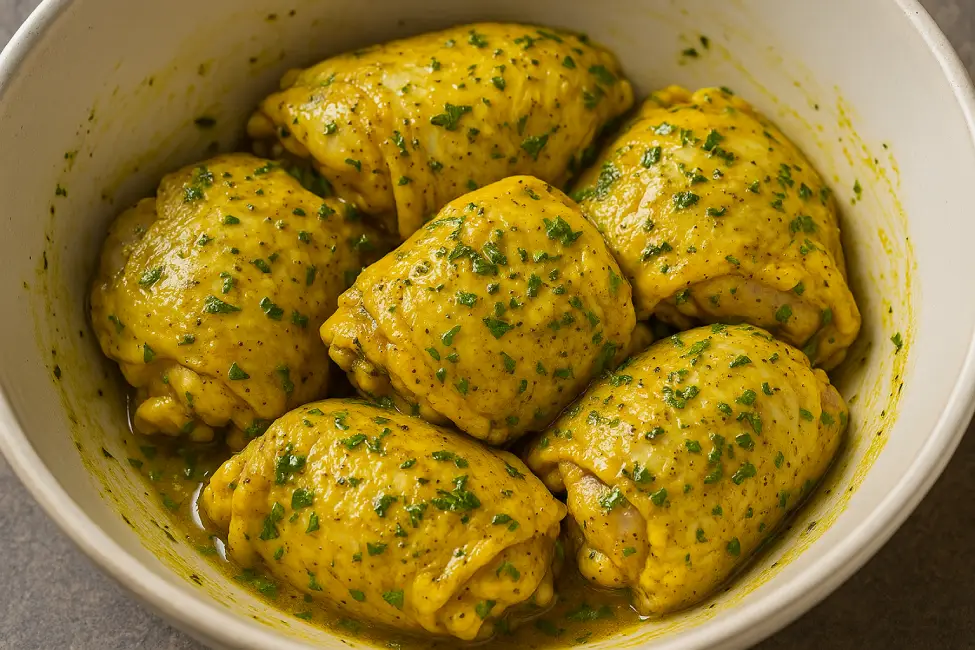
Cooking in a Traditional Tagine Pot
Important Note:
Traditional Moroccan kitchens often use a metal heat diffuser (called a “fer à tagine”) between the stovetop flame and the clay tagine pot. This simple, not-too-thick metal plate helps distribute heat evenly and prevents the tagine from cracking or burning on direct flame. If you’re cooking on a gas stove, always use one to protect your tagine and cook safely.
Using a tagine pot offers a slow, gentle cooking method that brings out deep flavor.
Warm the base gently on low heat with a drizzle of olive oil.
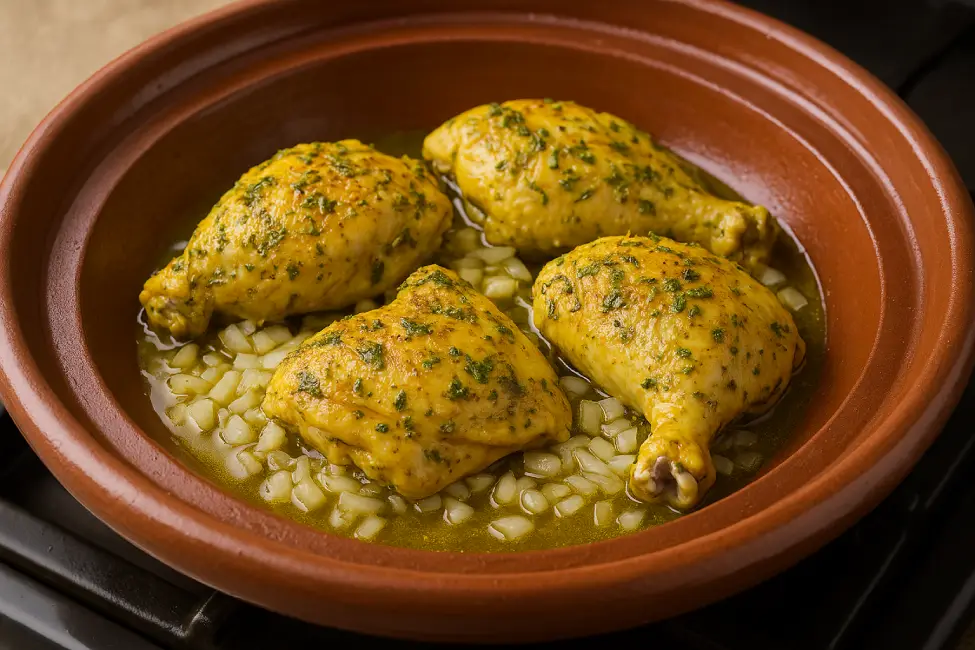
Spread half of the chopped onions to form a bed at the bottom.
Lay the chicken directly over the onions. Let them cook for about five minutes uncovered to start releasing their flavor.
Arrange the potato wedges over the chicken, then scatter the remaining onions, lemon rind slices, and olives on top.
Add a small amount of liquid, such as water or light stock, by pouring it along the sides so the marinade on the chicken stays intact.
Place the lid on the tagine and maintain low heat. Let the mixture simmer so the ingredients cook evenly without rapid boiling. A heat diffuser under the tagine helps protect the clay and manage the temperature.
Cook gently for about 40 to 50 minutes, checking now and then to ensure the sauce doesn’t dry out completely.
The dome of the tagine creates its steam cycle, which helps the food stay moist while the sauce develops naturally at the bottom.
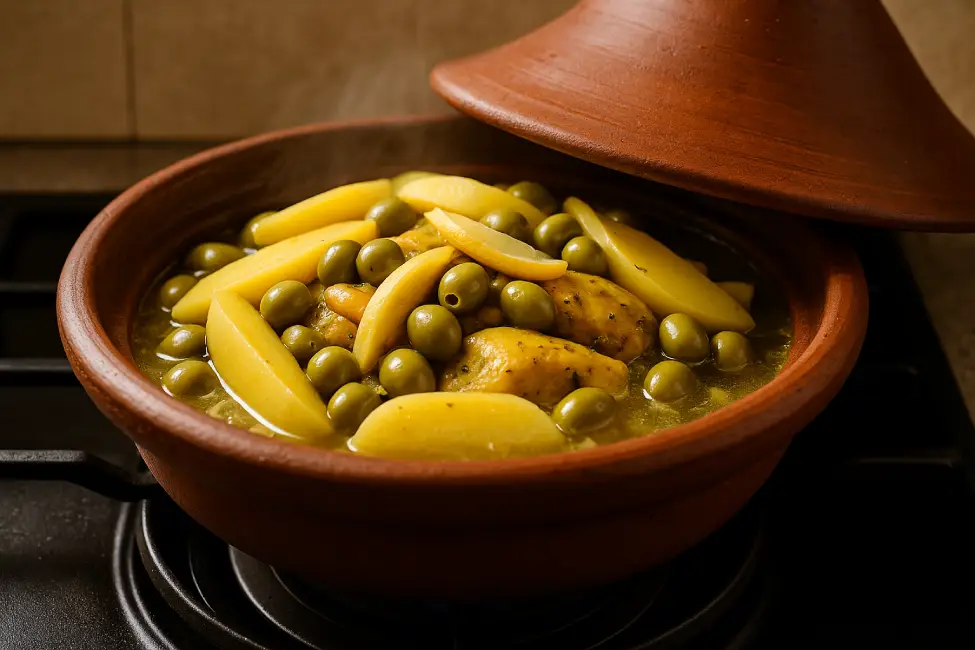
Making it in a Dutch Oven or Heavy Pot
No tagine pot? No problem. A Dutch oven or a heavy-bottomed pot works well, too.
Heat olive oil on medium heat.
Brown the chicken evenly on each side, then take it out temporarily.
Cook the chopped onion and garlic until they become translucent and lightly golden.
Return the chicken to the pot and add the potatoes, preserved lemons, and olives in even layers.
Pour in water or broth, bring to a low simmer, and then reduce the heat.
Cover the pot tightly and let everything cook over low heat for 45 to 60 minutes. The chicken should be tender, and the potatoes soft but not falling apart.
If you’d like the sauce to be slightly thicker, leave the lid just ajar during the last 10 minutes to let the excess liquid reduce naturally.
Dutch ovens trap heat well and mimic the slow, gentle cooking effect of a tagine.
The Cooking Process (Detailed Steps with Visual Cues)
Step 1: Brown the chicken.
Heat a bit of oil and cook the chicken just enough to form a light golden crust on the outside. This deepens the flavor of the finished dish.
Step 2: Sauté the aromatics.
Cook the onions and garlic together until softened and lightly browned to create a flavorful base.
Step 3: Layer the ingredients.
Set the chicken at the bottom. Top with potatoes, preserved lemon slices, and olives so they steam together gently.
Step 4: Add the liquid.
Pour a small amount of broth or water around the edges. This approach will generate steam without thinning the sauce too much.
Step 5: Simmer gently.
Cover and cook on low. Keep the temperature low to maintain the subtle flavors and prevent the ingredients from breaking down. Slight bubbling is ideal.
Step 6: Finish with fresh herbs.
Right before serving, scatter freshly chopped cilantro and parsley over the dish for color and aroma.
For a visual guide on authentic tagine cooking techniques, see this helpful tutorial from The Spruce Eats.
If you’re exploring more tagine recipes beyond chicken, try our Moroccan vegetable tagine for a flavorful plant-based option.
Serving Your Authentic Moroccan Tagine
Traditional Accompaniments
The best part of enjoying a Moroccan chicken tagine is what you serve with it. Choosing the right sides enhances both flavor and tradition.
Couscous:
Light and fluffy couscous is a classic pairing. It soaks up the rich sauce and makes every bite more satisfying. To learn how to prepare it properly, check out our Moroccan couscous recipe for simple, step-by-step instructions.
Khobz (Moroccan Bread)
This round, crusty bread is essential. It’s perfect for scooping up sauce, olives, and tender pieces of chicken without using utensils. Serve it warm for the full experience.
Simple Side Salads
Balance the richness of the tagine with refreshing vegetable sides:
- Tomato and cucumber salad dressed with olive oil and lemon
- Zaalouk, a smoky eggplant dip
- Taktouka, a warm blend of sautéed tomatoes and green bell peppers seasoned with spices
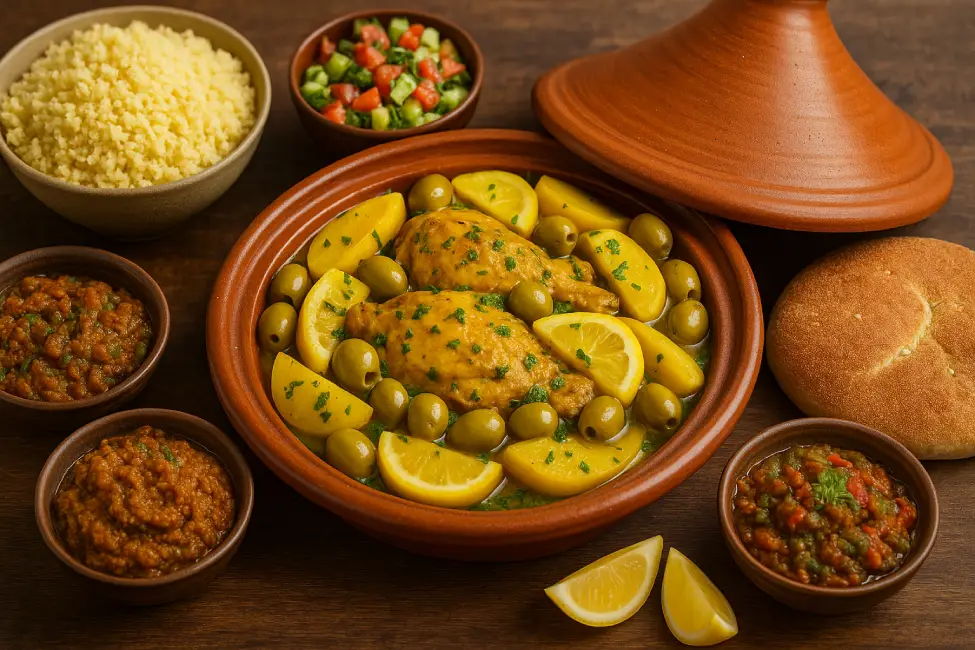
These salads are usually served at room temperature and offer a crisp contrast to the warm tagine.
Presentation Tips
Tagine is often served right in the cooking dish. Put the tagine on the table, lift the lid, and let the smell do the rest. This approach transforms the dish into a moment of connection around the table.
For a pop of color, top the dish with freshly chopped herbs. For those who enjoy an extra citrus touch, add lemon wedges on the side.
Serving the tagine this way isn’t just traditional; it’s practical. The clay pot keeps the dish hot, and everyone can help themselves.
For ideas on Moroccan-style presentation and how meals are traditionally shared, Saveur highlights authentic dining customs and serving practices in Moroccan homes.
Next, we’ll look at recipe variations, storage advice, and how to prepare this dish ahead of time for a stress-free mealtime.
Tips, Variations & Make‑Ahead for Your Tagine
Recipe Variations
One of the best things about Moroccan cuisine recipes is how adaptable they are. This chicken tagine can be modified based on your taste, dietary needs, or what you have on hand.
Chicken Cuts
If you prefer boneless chicken, thighs work better than breast meat because they stay tender during long cooking. You can also use drumsticks or even a mix of cuts for varied texture.
Adding Other Vegetables
You are welcome to include more vegetables to enrich the dish. Carrots add a touch of sweetness, zucchini softens nicely in the sauce, and peas bring color and lightness. To keep their shape, add soft vegetables later in the cooking process.
Spice Adjustments
To make it milder, reduce the ginger and black pepper. For extra warmth, you can add a small pinch of cayenne or paprika. Adjust the spices slowly to avoid overpowering the preserved lemon.
Olive and Lemon Ratio
The combination of olives and preserved lemons defines the flavor of this tagine. If you prefer a milder version, use fewer lemon rinds or switch to a softer olive variety. To intensify the tang, use more lemon or add a splash of the brine.
Make-Ahead & Storage Tips
Can It Be Made in Advance?
Yes, tagine actually tastes better the next day. The flavors deepen overnight, making it a perfect make-ahead meal.
Refrigeration
Allow the dish to cool, then store it in an airtight container in the fridge. It will keep well for up to three days.
Freezing
You can freeze the tagine without the potatoes, which tend to become grainy when thawed. Freeze the chicken and sauce, then add fresh potatoes when reheating.
Reheating Without Losing Texture
Warm slowly over low heat, adding a splash of water or broth if needed. Avoid high heat to keep the chicken moist and the sauce well-balanced. If using a microwave, cover the dish and reheat in short intervals, stirring gently between each.
For more tips on safely storing and reheating cooked poultry dishes, the Cleveland Clinic offers a clear and medically reviewed guide.
Are you curious about another hearty tagine that also keeps well? Our Moroccan beef tagine with preserved lemons and olives is a wonderful option to explore next.
Next, we’ll answer common questions about this recipe to help you troubleshoot and adapt with confidence.
Frequently Asked Questions (FAQs) About This Specific Tagine
Can I use regular lemons instead of preserved ones?
Using fresh lemons will not deliver the same result. Preserved lemons add a deep, salty-citrus note developed through fermentation, which fresh lemon juice or zest cannot replicate. To keep the authentic taste, stick with preserved lemon rind.
My sauce turned out too runny or too dry. What went wrong?
If your tagine is watery, it likely had too much liquid or simmered too gently. Remove the lid near the end of cooking to allow the sauce to reduce naturally.
If the sauce dried out, it might have cooked too long uncovered or on too high a heat. Next time, add a small amount of liquid during cooking and maintain low heat for a steady simmer.
I don’t own a tagine pot. Is there an alternative?
Absolutely. A Dutch oven or thick-bottomed pot with a tight-fitting lid can work just as well. The process stays the same, and you’ll still get flavorful results. In the cooking instructions section, we show you how to do it step by step.
How should I store leftover chicken tagine?
After letting the tagine cool naturally, store it in a tightly closed container in the fridge. It will hold its quality for about three days. Some even say it tastes more flavorful the next day, as the spices continue to blend.
Is it possible to make this tagine meat-free?
Yes, you can easily turn this recipe into a vegetarian dish. You can replace the chicken with hearty plant-based ingredients such as chickpeas, chunks of carrot, zucchini slices, or florets of cauliflower for a satisfying vegetarian version. Keep the preserved lemon and olives, as they bring the signature Moroccan flavor. Adjust your spices slightly to match the new ingredients.
For inspiration, take a look at our comforting Moroccan chicken and cauliflower tagine for another variation full of flavor and vegetables.
Conclusion
This tagine brings together the heart of Moroccan cuisine in one comforting dish. From the tang of preserved lemons to the earthy warmth of spices and the richness of tender chicken and potatoes, every bite tells a story of tradition and flavor. It’s a recipe that proves you don’t need complexity to achieve depth.
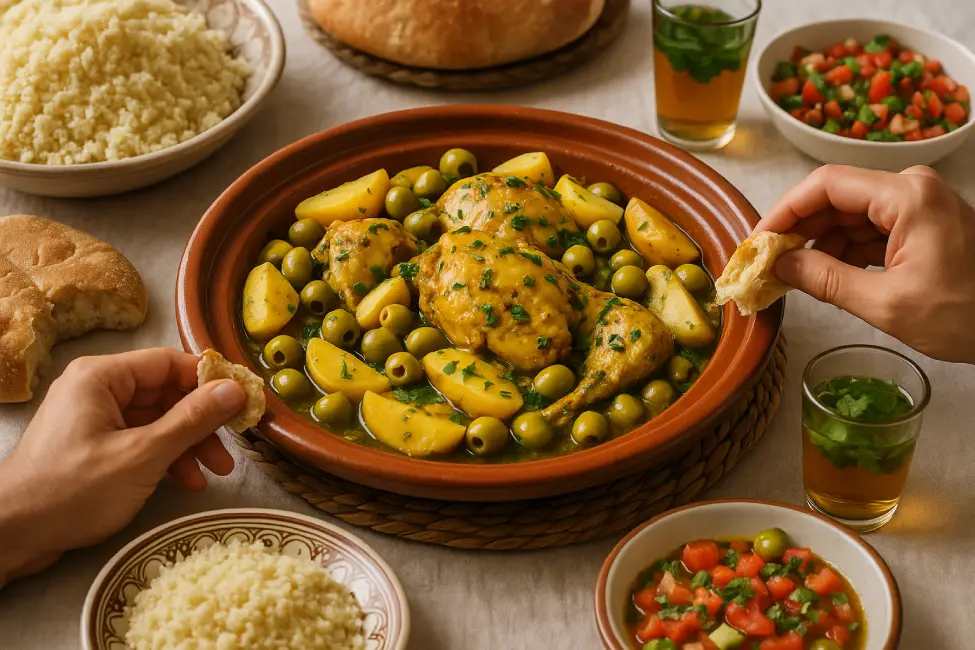
Give it a try in your kitchen, whether you’re cooking in a classic tagine or a Dutch oven. Let the aromas fill your home and share this taste of Morocco with family and friends.
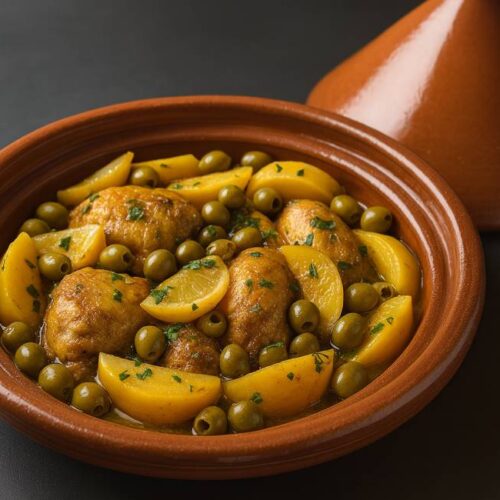
Moroccan Cuisine Recipes: Tagine with Potatoes, Olives, and Preserved Lemons
Equipment
- 1 Tagine or A Dutch oven
Ingredients
Ingredients:
- 4 bone-in skin-on chicken thighs or legs
- 3 medium potatoes Yukon Gold or red, peeled and cut into wedges
- 1 large onion finely chopped
- 3 garlic cloves minced
- 1 preserved lemon rind only, thinly sliced
- 100 g green olives preferably Beldi
- 2 tbsp olive oil
- 1 tsp turmeric
- 1 tsp ground ginger
- 1/2 tsp ground black pepper
- 1/2 tsp ground cumin
- Pinch of saffron threads optional
- Salt to taste
- Small handful of fresh parsley chopped
- Small handful of fresh cilantro chopped
- 1/2 cup light chicken broth or water
Instructions
Instructions:
- Mix olive oil, turmeric, ginger, pepper, garlic, and herbs. Rub over the chicken and let rest 20 minutes.
- In a tagine or Dutch oven, heat oil and spread half the onions at the bottom.
- Place chicken on top, then add potatoes, the rest of the onions, olives, and lemon rind.
- Pour broth around the edges.
- Cover and simmer on low heat for 45–50 minutes.
- Finish with chopped fresh herbs before serving.
Notes
- This is one of the most beloved Moroccan cuisine recipes, and it tastes even better the next day.
- You can adapt it for vegetarians by using chickpeas and seasonal vegetables.
- Always rinse preserved lemons well before using.
Nutrition Information (Per Serving)
| Nutrient | Amount |
|---|---|
| Calories | ~420 kcal |
| Protein | 28g |
| Fat | 24g |
| Saturated Fat | 6g |
| Carbohydrates | 22g |
| Fiber | 3g |
| Sugars | 2g |
| Sodium | 950mg |
| Potassium | 850mg |
| Vitamin C | 20% DV |
| Iron | 15% DV |
Values are approximate and based on standard ingredients. Actual amounts may vary depending on exact brands and preparation.
Moroccan Terms Used in This Recipe (With Explanations)
| Term | Meaning / Explanation |
|---|---|
| Tagine | A traditional Moroccan clay cooking vessel with a conical lid. The word also refers to the slow-cooked dish prepared in it. |
| Khobz | Round Moroccan bread with a firm crust and soft center, typically used to scoop up tagine and sauces. |
| Zaalouk | A warm eggplant and tomato salad, seasoned with garlic, olive oil, and spices. Served as a side dish. |
| Taktouka | A cooked salad made with green peppers and tomatoes, sautéed with olive oil, garlic, and spices. |
| Beldi olives | Traditional Moroccan green olives, often wrinkled and briny, known for their strong flavor. |
| Preserved lemon | Lemons fermented in salt and their own juices, a key ingredient in many Moroccan dishes. Only the rind is used in most recipes. |
Let’s Connect!
Love Moroccan cuisine and want more tips, traditional recipes, or creative twists to try at home? I share plenty of hands-on advice, time-saving tricks, and authentic ideas from real Moroccan kitchens, all made simple and accessible.
👉 You can find me on:
Where I post weekly food inspiration, behind-the-scenes cooking moments, and answer questions from readers like you.
Whether you’re making your first tagine or looking for new flavor combos, I’d love to hear from you. Tag me if you try this recipe, let’s keep the Moroccan food love going!
🌿 Join My Moroccan Kitchen Newsletter
Want more easy Moroccan recipes, cooking tips, and cultural food stories delivered straight to your inbox?
Sign up for my newsletter and get early access to new dishes, step-by-step guides, and subscriber-only extras. Whether you’re just starting with tagines or love trying something new each week, you’ll feel right at home here.
🧡 No spam, just real food, real flavor, and a bit of Moroccan warmth.
📩 Join Our Moroccan Foodie Community
Get the best Moroccan tagine recipes and seasonal culinary tips straight to your inbox.
💬 Share Your Thoughts!
Have you tried this Moroccan chicken tagine? I’d love to hear how it turned out for you!
Leave a comment below to share your experience, ask a question, or tell me how you adapted the recipe to make it your own.
Your feedback means a lot, it helps others and brings more flavor to this growing food community.
